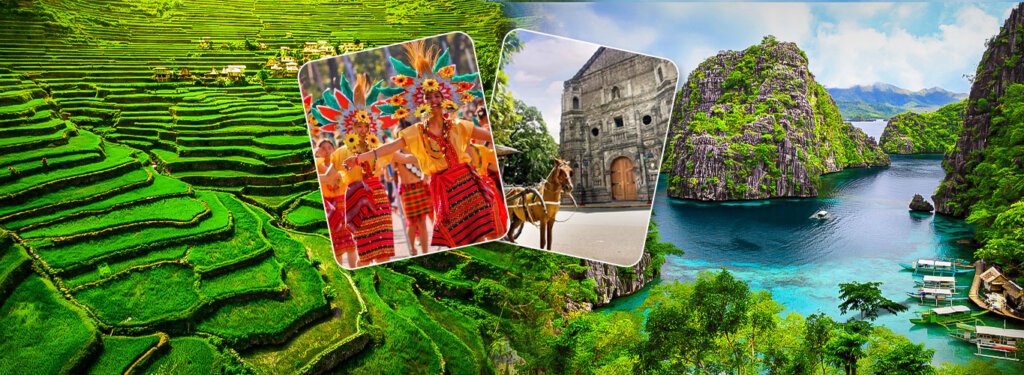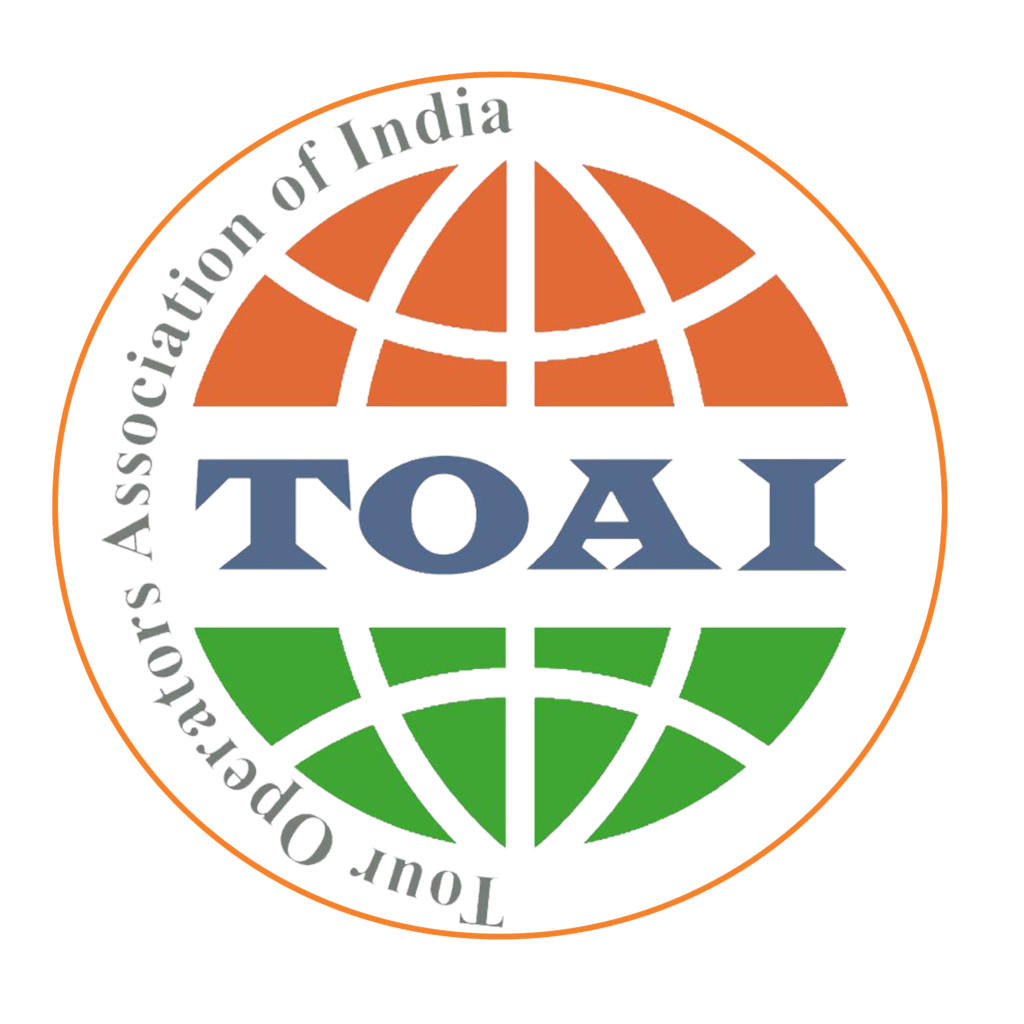
South India's No. 1 Travel Agency ✨
💱 Currency
Philippine Peso (PHP)
🗣️ Languages
Filipino and English
🌤️ Climate
26°C – 34°C
📅 Best Season
December – May (Dry Season)
March – May for beach trips
December – February for cooler temperatures
🛡 Must-Know Travel Tips for Visiting the Philippines
- 🏧 ATMs are common in cities and tourist areas, but may be scarce on remote islands — always carry enough cash when heading to rural or island destinations.
- 💳 Credit and debit cards are accepted in hotels, malls, and major restaurants, but small eateries, markets, and transport providers prefer cash.
- 🚕 Public transport is affordable but often chaotic — try ride-hailing apps like Grab for convenience in cities like Manila or Cebu.
- 🍸 The legal drinking age is 18, and alcohol is widely available in stores and bars, especially in urban and beach areas.
- 🙏 Filipinos are friendly and respectful — wearing modest clothing in churches or rural communities is appreciated.
- 💰 The Philippines is a great destination for island hopping, diving, and beach escapes — visit during the dry months for clear skies and smooth sailing.
What Is the Philippines Famous For? – About Philippines Explained
The Philippines is globally recognized for its breathtaking islands, crystal-clear turquoise waters, and incredible biodiversity, making it a dream escape for beach lovers and adventurers alike. Many Philippines tour packages highlight these natural wonders, drawing travelers to the country’s most scenic coastlines and hidden gems. This Southeast Asian archipelago is made up of more than 7,000 islands, each offering a distinct charm—whether it’s the powdery white sands of Boracay, the towering limestone cliffs of Palawan, or the vibrant marine life in the coral-rich waters of Cebu and Bohol. Beyond its landscapes, the country is also renowned for its warm and hospitable people, a mix of Asian and Western cultures, and a deep love for festivals, music, and food.
From diving with thresher sharks in Malapascua to exploring underground rivers in Puerto Princesa, and hiking volcanoes like Mayon and Taal, the Philippines is packed with adventure. Colonial architecture, Catholic churches, and centuries-old fortresses tell stories of Spanish influence, while vibrant local markets and colorful jeepneys reflect its modern-day spirit.Whether you’re interested in island hopping, cultural experiences, or discovering untouched nature, the Philippines offers an unmatched variety of experiences for all kinds of travelers.
Philippines Tour Packages
Most Chosen Philippines Plans by Our Happy Customers
How Are India and Philippines Connected? – Cultural & Historical Ties
India and the Philippines may be geographically distant, but their cultural and historical ties run deep, shaped by centuries of trade, religion, and mutual influence. Ancient trade routes brought Indian merchants and cultural ideas to the islands of the Philippines long before the arrival of European colonizers. These early exchanges introduced elements of Indian mythology, language, art, and spiritual practices that are still subtly visible in Filipino traditions today.One of the most profound cultural imprints is in linguistic influence—several Filipino words have roots in Sanskrit and Tamil. In pre-colonial times, Indian epics like the Ramayana and Mahabharata were shared orally in the form of folk tales, and many ancient kingdoms in the Philippines were ruled by leaders influenced by Indian Hindu-Buddhist governance models.
In modern times, the two countries share strong diplomatic relations, educational exchange programs, and a growing economic partnership. There’s a visible Indian diaspora in the Philippines, particularly in cities like Manila, Cebu, and Davao, where Indian cuisine, temples, and businesses thrive. At the same time, Filipino professionals have been increasingly welcomed in India’s business process and hospitality industries.Cultural collaborations continue to grow through film festivals, academic initiatives, and youth exchanges, reinforcing a relationship that is as much rooted in shared values of family, spirituality, and hospitality as it is in economic and diplomatic cooperation. Today, both nations enjoy a warm bond that celebrates diversity while building bridges through tourism, trade, and education.
Interesting Things to Know About Philippines Before You Go
Before heading to the Philippines, there are a few fascinating and practical things travelers should know to make their trip smoother and more enjoyable. First, the country is made up of over 7,000 islands, divided into three major regions—Luzon, Visayas, and Mindanao—each with its own culture, dialect, and attractions. While English is widely spoken and understood, especially in tourist areas, there are over 170 languages and dialects spoken throughout the country, with Filipino (Tagalog) as the national language.Filipinos are known for their warm hospitality, and it’s common to be treated like family, especially when visiting rural areas. The culture places high value on respect and friendliness, so a smile and a polite greeting go a long way. It’s also a deeply Catholic country, with religious festivals like Sinulog, Ati-Atihan, and Pahiyas drawing huge crowds, colorful parades, and elaborate costumes.
Transportation between islands usually requires domestic flights or ferry rides, so planning ahead is essential.The Philippines has a tropical climate marked by distinct dry and rainy seasons. The best time to visit is generally between November and May, when the weather is sunny and ideal for beach activities and island hopping. For culinary enthusiasts, the Philippines serves up a distinctive blend of flavors shaped by Spanish, Chinese, American, and Malay influences. Signature dishes such as adobo, lechon, kare-kare, and halo-halo reflect the country’s rich food heritage, while an abundance of fresh seafood adds to its coastal charm. The street food scene is equally dynamic, tempting adventurous palates with bold offerings like isaw (grilled chicken intestines) and balut (a fertilized duck egg). One interesting fact is that karaoke is a national pastime—you’ll find karaoke machines in homes, restaurants, and even on sidewalks. Filipinos love to sing, and it’s often part of family gatherings or festivals. Lastly, travelers should note that Wi-Fi can be spotty, especially on remote islands, and ATMs aren’t always available in rural areas, so it’s best to carry some cash. With a little preparation, your trip to the Philippines can be an unforgettable experience filled with natural wonders, warm people, and meaningful cultural moments.
What to Know Before Booking a Philippines Tour Package
Booking a Philippines tour package is an exciting step, but it’s important to make informed decisions to ensure a smooth and enjoyable trip.Before you confirm your booking, consider the type of experience you’re looking for. If you want crystal-clear waters and postcard-perfect beaches, head for Palawan or Boracay. For culture and history, explore Vigan, Manila, or Cebu. Adventure seekers should look at Davao or Bohol for hiking, caving, and scuba diving. Timing is crucial. The dry season from November to April is ideal for beach travel and island-hopping, but it’s also the peak tourist season, meaning higher prices. The monsoon or wet season (May to October) sees fewer crowds and better deals, though rain might affect your plans. Make sure the package you choose matches your travel dates and weather preferences. Another key factor is understanding the internal travel system. Since many tourist spots are on different islands, local flights, ferries, and vans are common modes of transportation. Ensure your package includes accommodation in centrally located or safe areas, especially if you’re a first-time visitor. Indian travelers should also check visa requirements. Those holding a valid visa or permanent residence from countries like the US, UK, Canada, Schengen Area, or Japan are eligible for visa-free entry up to 14 days. For others, a visa is required, and processing can take a few days, so plan ahead. Additionally, check for COVID-19 travel advisories, health insurance requirements, and any necessary vaccinations. Lastly, opt for tour operators that offer local guides, customizable itineraries, and transparent inclusions/exclusions in the package. Hidden costs for island fees, environmental taxes, or optional activities can add up. Read reviews, compare prices, and don’t hesitate to ask the operator about fine details.
Which Are the Best Budget Philippines Tour Packages?
For Indian travelers eager to explore tropical beauty on a budget, the Philippines offers incredible value through well-curated tour packages. With affordable transportation, low-cost accommodations, and plenty of free or inexpensive attractions, it’s possible to enjoy an unforgettable vacation without overspending.
One of the top low-budget options is the Manila–Tagaytay–Batangas circuit (4–5 days). This itinerary provides a relaxing mix of city sightseeing, scenic mountain views from Tagaytay’s Taal Volcano, and beach escapes in Batangas—all within driving distance, which reduces travel costs significantly. Because it doesn’t require internal flights, it’s perfect for short-stay travelers. Another highly recommended option is the Cebu–Bohol combo (5–6 days). In Cebu, you can explore historical landmarks, dive with whale sharks in Oslob, and then take a short ferry to Bohol to witness the world-famous Chocolate Hills and tiny tarsiers. These destinations are popular among budget-conscious travelers due to economical accommodations, local eateries, and shared group tours.
For nature lovers, a Palawan tour covering Puerto Princesa and El Nido (5–7 days) offers exceptional natural beauty without luxury price tags. You can visit the Puerto Princesa Underground River (a UNESCO site), enjoy affordable lagoon-hopping tours in El Nido, and stay in hostels or beachside cottages that cater to backpackers.
When creating a Philippines tour plan, look for packages that include essentials like airport transfers, group excursions, and daily breakfasts. Traveling during the off-season (May to October) not only reduces package costs but also means fewer crowds. Using local transport such as jeepneys or tricycles and dining at “carinderias” (local food stalls) also helps keep your budget in check. Whether you’re solo or in a group, budget Philippines packages deliver real value. Many tour operators offer customizable plans to suit your travel style and duration, allowing you to experience the charm of the islands without financial strain.
Quick Facts About Philippines – Geography, Wildlife & People
The Philippines is a spectacular archipelago in Southeast Asia, stretching over 300,000 square kilometers across the Pacific Ocean. It consists of 7,641 islands grouped into three major regions—Luzon, Visayas, and Mindanao—each offering its own unique geography, culture, and biodiversity. The country is located along the Pacific Ring of Fire, making it home to over 20 active volcanoes, including the iconic Mount Mayon with its perfect cone shape, and Taal Volcano, one of the smallest active volcanoes in the world. Geographically, the Philippines is defined by its dramatic landscapes—lush rainforests, coral reefs, limestone cliffs, volcanic mountains, and expansive rice terraces like those in Banaue, a UNESCO World Heritage Site. The country also features incredible natural wonders like the Puerto Princesa Underground River, Hinatuan Enchanted River, and the surreal Chocolate Hills. When it comes to wildlife, the Philippines is a biodiversity hotspot. It’s one of the world’s 17 megadiverse countries, home to over 52,000 species, many of which are endemic. Some of the rarest animals found here include the Philippine Eagle, the world’s largest eagle in terms of wingspan; the Philippine tarsier, a small primate with enormous eyes; and the Visayan warty pig. The surrounding seas are part of the Coral Triangle, with world-class diving sites like Tubbataha Reef offering encounters with manta rays, sea turtles, and over 2,000 species of fish and coral. Culturally, the people of the Philippines—called Filipinos—are known for their friendliness, hospitality, and vibrant community life. Most people speak Filipino and English, and communication is easy for Indian travelers. The country is also predominantly Christian, with festivals like Sinulog, Ati-Atihan, and Pahiyas showcasing religious fervor, dance, and street parades. The population is youthful, diverse, and highly urbanized in areas like Manila, Cebu, and Davao. Filipino cuisine reflects its rich cultural mix, with dishes like lechon (roast pig), kare-kare (peanut stew), and halo-halo (shaved ice dessert) gaining international fame. Filipinos are also known for their musical talents, warm smiles, and strong family values, making tourists feel welcome wherever they go.
Philippines Tour Packages
| High Season | December to May (Dry Season), March to May (Beach Season), December to February (Cooler, Festive Months) |
|---|---|
| Iconic Attractions | Chocolate Hills (Bohol), Banaue Rice Terraces, Taal Volcano, Palawan Islands, Mayon Volcano |
| Popular Activities | Island Hopping, Snorkeling & Diving, Whale Shark Watching, Trekking, Surfing |
| Visa | Visa-free entry for 30 days for many countries (including India); extendable |
| National Animal | Philippine Eagle (Haribon) — one of the world’s rarest and largest eagles |
| National Flower | Sampaguita (Jasmine) |
| Famous Food | Adobo, Sinigang, Lechon, Kare-Kare, Halo-Halo, Pancit, Lumpia |
Top 10 Reasons Why Tourists Love Visiting Philippines
The Philippines never fails to enchant visitors with its stunning landscapes, rich cultural heritage, and the genuine warmth of its people. From stunning beaches to unique experiences, here are the top reasons why tourists fall in love with this tropical paradise: The country’s beaches are world-famous, featuring powdery white sands and clear blue waters. Places like Boracay, El Nido, and Panglao are often ranked among the most beautiful beach destinations in the world. These postcard-perfect shorelines make it ideal for sunbathing, beach games, or simply relaxing with a view of the ocean. The Philippines is also one of the best diving and snorkeling spots on the planet. With rich coral reefs, vibrant marine life, and shipwrecks to explore, areas like Tubbataha Reefs Natural Park and Apo Island offer unforgettable underwater adventures. The biodiversity beneath the waves is as impressive as the scenery above. Island hopping is a major draw. With over 7,000 islands, travelers can explore hidden lagoons, sandbars, waterfalls, and remote villages—all within a single trip. Each island has its own character, from the party vibes of Siargao to the serene landscapes of Batanes. Hospitality is deeply ingrained in Filipino culture. Visitors are treated like family, and the locals are known for their friendliness, generosity, and willingness to help. Whether you’re in a major city or a remote province, expect warm smiles and genuine conversations.Cultural richness is another highlight. With a mix of indigenous, Spanish, American, and Asian influences, the Philippines boasts colorful festivals, historic churches, and centuries-old traditions. Events like Sinulog, Ati-Atihan, and Pahiyas showcase the country’s deep love for celebration. The food scene is evolving and exciting. From savory dishes like adobo and kare-kare to sweet treats like halo-halo, Filipino cuisine blends comfort, flavor, and creativity. Street food culture also thrives, especially in Manila and Cebu.
For nature lovers, the country is a haven of biodiversity. Beyond its marine life, the Philippines is home to volcanoes, rice terraces, caves, rivers, and rare wildlife like the tarsier and the Philippine eagle. Destinations like Banaue, Sagada, and Mt. Mayon offer both adventure and scenic beauty. Travel is affordable and accessible. Whether you’re a backpacker or a luxury traveler, the Philippines offers experiences for every budget. Accommodations range from beach huts to high-end resorts, and local transport—though rustic—is part of the charm. English is widely spoken, making it easy for travelers to communicate, ask for directions, or connect with locals. This ease of interaction enhances comfort and allows for deeper cultural immersion. Finally, the laid-back island lifestyle encourages slow travel and meaningful connections. Whether you’re watching the sunset over Palawan, enjoying a boat ride in Bohol, or singing karaoke with locals, the Philippines invites you to unwind, explore, and truly feel at home.
When Is the Best Time to Visit the Philippines for Travel?
The Philippines has a tropical climate, making it a year-round destination, but certain months are ideal for specific activities and regions. The best overall time to visit is during the dry season, which runs from November to May. During these months, the weather is generally sunny, humidity is lower, and conditions are perfect for island hopping, beach vacations, diving, and outdoor adventures.December to February offers cool breezes and mild temperatures, especially in the highland regions like Baguio and Sagada. This is the peak tourist season, especially around Christmas and New Year, so booking accommodations and flights early is recommended.
For those who want to experience beach holidays, March to May is ideal. This is summer in the Philippines—hotter and drier—making it perfect for water sports, snorkeling, and coastal travel. The crystal-clear waters of Palawan, Boracay, and Siargao are at their best during this time.From June to October, the country experiences the wet season, with a higher risk of typhoons, especially in the eastern and northern parts. While travel is still possible, it’s less predictable due to heavy rains and possible weather disruptions. However, some regions in the southern Philippines—such as Davao or Siargao—remain relatively unaffected and can still be explored.Although the Philippines does not offer traditional African-style wildlife safaris, nature lovers can still enjoy eco-tourism experiences such as whale shark watching in Donsol, river safaris in Bohol, firefly watching in Palawan, and bird-watching in forest reserves across Luzon and Mindanao.
What Are the Best Things to Do in the Philippines?
The Philippines is packed with diverse activities for all kinds of travelers, offering a mix of relaxation, adventure, culture, and natural beauty. Many Philippines tour packages are designed to combine these experiences, giving visitors a well-rounded taste of the country’s best highlights.Diving and snorkeling are world-class, especially in spots like Apo Island, Tubbataha Reefs, and Moalboal, where travelers can swim with sea turtles, colorful fish, and even whale sharks. For non-divers, kayaking, paddleboarding, and sailing also offer fantastic ways to enjoy the water.Adventure awaits on land too. Travelers can hike up active volcanoes such as Mount Mayon or Mount Pinatubo, visit the Chocolate Hills in Bohol, or trek to see the centuries-old Banaue Rice Terraces. The pine forests and hanging coffins of Sagada offer a more mystical and serene experience.
Cultural exploration is just as rewarding. In Manila, Intramuros provides a journey through Spanish colonial history with its cobblestone streets and old churches. Other heritage towns like Vigan showcase beautiful preserved architecture, horse-drawn carriages, and traditional crafts.Festivals like Sinulog, Panagbenga, and Kadayawan are vibrant, colorful celebrations filled with music, dance, and community spirit. These events offer visitors a deeper connection to local traditions and joyful Filipino culture.Whether it’s relaxing on white-sand beaches, exploring underground rivers, joining a food tour, or singing karaoke with locals, the Philippines offers memorable experiences that make every trip exciting and unique.
What Food Is the Philippines Known For? – A Guide to Philippines Cuisine
Filipino cuisine brings together native traditions and Spanish, Chinese, and American influences to create a rich, comforting, and distinctly flavorful food culture.At its core, Filipino food is all about bold flavors, balance, and communal dining. Adobo is the most iconic dish, typically made with chicken or pork simmered in soy sauce, vinegar, garlic, and bay leaves. It’s savory, slightly tangy, and deeply satisfying. Another favorite is sinigang, a tamarind-based sour soup filled with meat or seafood and vegetables, offering a refreshing contrast to the tropical heat.It features crispy skin and juicy meat and is often regarded as the best in Cebu. Kare-kare, a peanut-based stew with oxtail and vegetables, is rich and creamy, often served with bagoong (fermented shrimp paste) on the side.Variations include pancit canton, palabok, and bihon. Lumpia, Filipino spring rolls, are either fresh or fried and typically served with a sweet or spicy sauce.For dessert, halo-halo is a must-try. Other sweets like bibingka (rice cake) and puto (steamed rice muffin) are common during holidays and fiestas.Street food culture is also vibrant. Adventurous eaters can try balut (a fertilized duck egg), isaw (grilled chicken intestines), and kwek-kwek (quail eggs in orange batter). Fresh tropical fruits like mangoes, bananas, and lanzones are found in markets and roadside stalls across the country.Filipino meals are typically eaten with rice and enjoyed family-style.
Philippines Tour Packages
| Manila | Intramuros (Walled City), Rizal Park, Fort Santiago, Manila Cathedral, National Museum |
|---|---|
| Cebu | Magellan’s Cross, Basilica del Santo Niño, Kawasan Falls, Temple of Leah, Osmeña Peak |
| Palawan | Puerto Princesa Underground River, El Nido Limestone Cliffs, Coron Shipwreck Diving, Kayangan Lake |
| Boracay | White Beach, Willy’s Rock, Nightlife, Sunset Sailing, Beachfront Dining |
| Bohol | Chocolate Hills, Tarsier Sanctuary, Loboc River Cruise, Panglao Island Beaches, Hanging Bridge |
| Davao | Philippine Eagle Center, Mount Apo, Eden Nature Park, Crocodile Park, Durian Farms |
| Baguio | Burnham Park, Session Road, Mines View Park, Strawberry Farms, Baguio Cathedral, Cool Mountain Climate |
What Should Indian Travellers Know Before Visiting Philippines?
Indian travellers will find the Philippines to be a welcoming and culturally rich destination that blends Southeast Asian warmth with Western influences. First and foremost, Indian passport holders must apply for a visa before traveling. However, those who already hold a valid visa for the USA, UK, Japan, Schengen, Canada, or Australia may be eligible for a visa-free stay of up to 14 days, which simplifies travel for many.Flights from major Indian cities like Delhi, Mumbai, and Chennai to Manila or Cebu are available, often with one stop. The Philippines is spread across thousands of islands, so internal travel may require a mix of domestic flights and ferries.
English is widely spoken across the Philippines, making communication easy for Indian tourists.Whether you’re dreaming of white-sand beaches, crystal-clear waters, or vibrant city life, our Philippines tour plan brings it all together for the perfect vacation. The Filipino people are known for their friendliness and hospitality, and Indian visitors are warmly received in both urban and rural areas.Food is another important consideration. While Filipino cuisine is meat-heavy and often includes pork, vegetarian and Indian food options are increasingly available in cities like Manila, Makati, and Cebu. Still, carrying some ready-to-eat meals or snacks may be helpful when venturing to remote islands.Currency used is the Philippine Peso (PHP), and it’s advisable to exchange money at airports or authorized counters. Credit cards are accepted in major areas, but cash is necessary in local markets and island resorts. Finally, it’s a good idea to carry travel insurance, especially if planning water sports or adventure activities.
Where to Shop in Philippines – Best Markets & Souvenirs
Shopping in the Philippines is a fun and vibrant experience that reflects the country’s rich cultural heritage and artistic flair. From handcrafted trinkets to fashionable pieces and natural wellness items, the country offers a range of unique souvenirs.In Manila, Greenhills Shopping Center is a go-to spot for pearls, traditional Barong Tagalog shirts, and fashion items at bargain prices. Divisoria Market, though chaotic, is perfect for those who love to haggle and discover hidden gems. For a more modern experience, SM Mall of Asia—one of the largest malls in Asia—features both international brands and local products.In Cebu, don’t miss the Carbon Market or Taboan Market, where you can buy dried mangoes, handmade crafts, local delicacies, and traditional Cebuano items. In Palawan and Bohol, souvenir stalls near beaches offer locally made shell jewelry, woven bags, bamboo crafts, and organic soaps.
Kultura Filipino, a store chain found in many major malls, offers a curated selection of Filipino-made items like abaca handicrafts, native home decor, traditional textiles, and food products—perfect for authentic, high-quality souvenirs.Some of the best things to buy include: capiz shell lamps, woven rattan bags, T’nalak textiles from Mindanao, wood carvings from the Cordilleras, and locally produced coffee and chocolate. Whether in bustling markets or boutique shops, shopping in the Philippines offers a window into the country’s creativity, heritage, and charm.
How Is the Art and Culture Scene in the Philippines?
The Philippines boasts a rich, diverse, and dynamic cultural landscape that draws from its indigenous roots, centuries of Spanish colonial influence, and modern global connections. Art and culture are alive not just in galleries and theaters, but also in the streets, homes, and festivals that dot the islands throughout the year.Traditional arts include weaving, pottery, and wood carving, especially in the Cordillera and Mindanao regions. The Ifugao people, for instance, are known for their rice terrace culture and elaborate ceremonial carvings. Muslim communities in Mindanao produce intricate brass works, woven mats, and colorful textiles that reflect their rich heritage.Spanish influence is especially visible in architecture, Catholic religious celebrations, and the country’s love for music and dance. Cities like Vigan preserve colonial-era houses, cobblestone streets, and horse-drawn carriages, offering a nostalgic glimpse into the past. Throughout the year, cultural festivals like Sinulog, Ati-Atihan, and Pahiyas showcase regional traditions with vibrant costumes, lively parades, and deep community spirit.Contemporary art in the Philippines is thriving, particularly in urban areas like Manila, Makati, and Quezon City. Museums such as the National Museum of Fine Arts and Ayala Museum house a blend of historical and modern works, while art spaces like Art Fair Philippines promote emerging Filipino artists. Street murals, independent film, and spoken-word poetry are also part of the country’s growing creative expression.Music is another pillar of cultural identity. Traditional instruments like the kulintang and kudyapi coexist with popular genres like pop, rock, and folk..For travelers seeking deeper cultural immersion, many include activities like pottery classes, weaving demonstrations, and heritage walks in their Philippines tour plan to experience art and tradition firsthandEngaging with local culture deepens the travel experience and offers a true glimpse into the heart of the islands.















